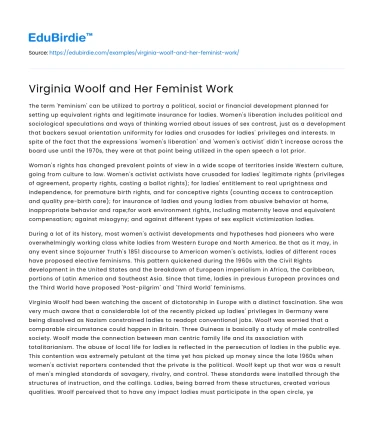The term 'Feminism' can be utilized to portray a political, social or financial development planned for setting up equivalent rights and legitimate insurance for ladies. Women's liberation includes political and sociological speculations and ways of thinking worried about issues of sex contrast, just as a development that backers sexual orientation uniformity for ladies and crusades for ladies' privileges and interests. In spite of the fact that the expressions 'women's liberation' and 'women's activist' didn't increase across the board use until the 1970s, they were at that point being utilized in the open speech a lot prior.
Woman's rights has changed prevalent points of view in a wide scope of territories inside Western culture, going from culture to law. Women's activist activists have crusaded for ladies' legitimate rights (privileges of agreement, property rights, casting a ballot rights); for ladies' entitlement to real uprightness and independence, for premature birth rights, and for conceptive rights (counting access to contraception and quality pre-birth care); for insurance of ladies and young ladies from abusive behavior at home, inappropriate behavior and rape;for work environment rights, including maternity leave and equivalent compensation; against misogyny; and against different types of sex explicit victimization ladies.
Save your time!
We can take care of your essay
- Proper editing and formatting
- Free revision, title page, and bibliography
- Flexible prices and money-back guarantee
During a lot of its history, most women's activist developments and hypotheses had pioneers who were overwhelmingly working class white ladies from Western Europe and North America. Be that as it may, in any event since Sojourner Truth's 1851 discourse to American women's activists, ladies of different races have proposed elective feminisms. This pattern quickened during the 1960s with the Civil Rights development in the United States and the breakdown of European imperialism in Africa, the Caribbean, portions of Latin America and Southeast Asia. Since that time, ladies in previous European provinces and the Third World have proposed 'Post-pilgrim' and 'Third World' feminisms.
Virginia Woolf had been watching the ascent of dictatorship in Europe with a distinct fascination. She was very much aware that a considerable lot of the recently picked up ladies' privileges in Germany were being dissolved as Nazism constrained ladies to readopt conventional jobs. Woolf was worried that a comparable circumstance could happen in Britain. Three Guineas is basically a study of male controlled society. Woolf made the connection between man centric family life and its association with totalitarianism. The abuse of local life for ladies is reflected in the persecution of ladies in the public eye. This contention was extremely petulant at the time yet has picked up money since the late 1960s when women's activist reporters contended that the private is the political. Woolf kept up that war was a result of men's mingled standards of savagery, rivalry, and control. These standards were installed through the structures of instruction, and the callings. Ladies, being barred from these structures, created various qualities. Woolf perceived that to have any impact ladies must participate in the open circle, yet she contended, ladies ought to hold their distinction and not receive the very mentalities that they expected to change.
Three Guineas is a generally dismissed work of Woolf's that merits more prominent consideration as it is key to an understanding Woolf's women's liberation. Her connecting of the private and the general population, and how the structures of man centric culture lead to militarism is as yet a difficult contention for the present world.
A Room Of One’s Own is also a non-fictional work of Virginia Woolf which is also considered as one of her feminist work. It is basically an exaggerated version of her essay which she delivered in a college during her lecture. The paper is viewed as a women's activist content, and is noted in its contention for both a strict and figural space for ladies journalists inside an artistic custom overwhelmed by male controlled society.






 Stuck on your essay?
Stuck on your essay?

